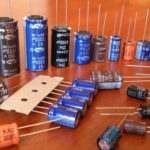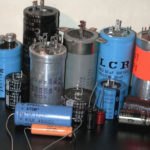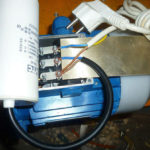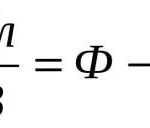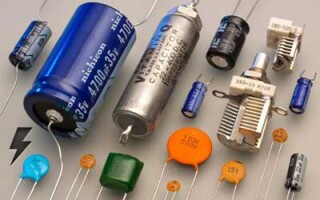An electric capacitor is one of the elements in the electrical circuit of any electronic device, whose main function is to store energy and then release it back into the circuit. The industry offers a wide variety of capacitors, differing in type, capacity, size, and application.
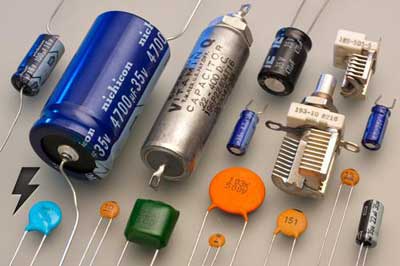
Capacitor principle and characteristics
A capacitor consists of two metallic shells separated by a thin dielectric layer. The ratio of the size and arrangement of the covers and the dielectric material characteristic determines the capacitance value.
The design of any type of capacitor is aimed at obtaining the maximum capacitance in relation to the minimum size to save space on the printed circuit board of the device. One of the most popular shapes in terms of appearance is in the form of a keg, with metal covers twisted together with dielectric between them. The first capacitor, invented in Leiden, Netherlands, in 1745, was called the "Leiden Can".
The principle of the component is the ability to charge and discharge. Charging is made possible by keeping the electrodes a short distance from each other. Closely spaced charges separated by the dielectric are attracted to each other and trapped on the terminals, and the capacitor itself thus stores energy. When the power supply is switched off, the component is ready to release energy into the circuit, to discharge.
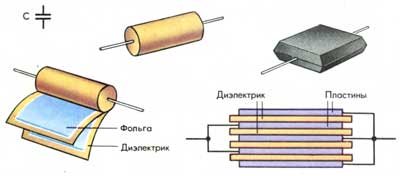
Parameters and properties that determine performance, quality, and longevity of operation:
- electrical capacitance;
- specific capacitance;
- tolerance;
- electrical strength;
- intrinsic inductance;
- dielectric absorption;
- losses;
- stability;
- reliability.
The ability to store charge determines the electrical capacitance of a capacitor. In calculating the capacitance you need to know:
- the area of the windings;
- the distance between the facets;
- dielectric permittivity of the dielectric material.
To increase the capacitance, you need to increase the area of the covers, decrease the distance between them, and use a dielectric material with a high dielectric constant.
The unit of measure used for capacitance is the Farad (F), named after the English physicist Michael Faraday. However, 1 Farad is too large a value. For example, the capacitance of our planet is less than 1 Farad. In radio electronics, smaller values are used: microfarads (µF, one-millionth of a Farad) and picofarads (pF, one-millionth of a microfarad).
Specific capacitance is calculated from the ratio of capacitance to dielectric mass (volume). This figure is affected by geometric dimensions, and increasing the specific capacitance is achieved by reducing the dielectric volume, but it increases the risk of breakdown.
The allowable deviation of the nameplate capacitance value from the actual capacitance value determines the accuracy class. According to GOST, there are 5 accuracy classes that determine future use. Components of the highest accuracy class are used in high responsibility circuits.
Electrical strength determines the ability to hold a charge and retain performance properties. Charges retained on the coils tend towards each other, affecting the dielectric. Electrical strength is an important property of a capacitor that determines how long it will last. Improper operation will result in dielectric breakdown and component failure.
The intrinsic inductance is taken into account in AC circuits with inductance coils. It is not taken into account for DC circuits.
Dielectric absorption - The appearance of voltage on the coils during rapid discharge. The absorption phenomenon is taken into account for the safe operation of high voltage electrical devices because there is danger to life in the event of a short circuit.
Losses are caused by the low current carrying capacity of the dielectric. When electronic components are operated under different temperatures and humidity conditions, the quality factor of the losses has an effect. It is also affected by the operating frequency. At low frequencies, dielectric losses are affected, at high frequencies, metal losses are affected.
Stability is a capacitor parameter that is also affected by ambient temperature. Its effects are divided into reversible, characterized by the temperature coefficient, and irreversible, characterized by the temperature instability coefficient.
The reliability of a capacitor primarily depends on the operating conditions. Failure analysis indicates that breakdowns are the cause of failure in 80% of cases.
Depending on the purpose, type and application, the capacitors are also sized differently. The smallest and tiniest, ranging in size from a few millimeters to a few centimeters, are used in electronics, and the largest are used in industry.
Purpose
The property of storing and releasing energy has determined the wide use of capacitors in modern electronics. Along with resistors and transistors, they are the backbone of electrical engineering. There is not a single modern device where they are not used in some capacity.
Their ability to charge and discharge, together with inductance, which has the same properties, is actively used in radio and television technology. The oscillating circuit of capacitor and inductance is the basis for the transmission and reception of signals. Changing the capacitor's capacitance makes it possible to change the frequency of the oscillating circuit. For example, radio stations can transmit on their frequencies and radios can connect to those frequencies.
An important function is the smoothing of AC pulsations. Any AC-powered electronic device needs filtering electrical capacitors to produce good quality DC current.
The charging and discharging mechanism is actively used in photographic equipment. All modern cameras use a flash to take pictures, which is realized through the property of rapid discharge. In this area, it is unprofitable to use batteries which can store energy well but give it away slowly. Capacitors, on the other hand, instantly give up all the stored energy, which is enough for a bright flash.
The ability of capacitors to generate pulses of high power is used in radiolocation and the creation of lasers.
Capacitors perform the role of spark-quenching contacts in telegraphy and telephony, as well as telemechanics and automation, where high-load relays need to be switched.
Voltage regulation of long transmission lines is carried out through the use of compensation capacitors.
Modern capacitors, due to their capabilities, are used not only in the field of radio electronics. They are used in metal processing, mining, coal industry.
Main varieties
Because of the diversity of applications and operating conditions of electronic devices, there is a large variety of components, differing in types and characteristics. The main division goes by classes and by the type of dielectric used.
Types of capacitors divided by class:
- With constant capacitance;
- with variable capacitance;
- trimmers.
Constant capacitance components are used in every radioelectronic device.
Variable capacitors are used to change capacitance and circuit parameters, such as frequency in oscillating circuits. In their construction they have several sections of metal moving plates, which ensures their longevity.
The tuning capacitors are used for a single adjustment of the equipment. They are available in various capacitance ratings (from a few picofarads to several hundred picofarads) and are designed for voltages up to 60 volts. Without their use, fine tuning of equipment is impossible.
Types of capacitors divided by dielectric type:
- With ceramic dielectric;
- with a film dielectric;
- electrolytic;
- ionistors.
Ceramic capacitors are made in the form of a small plate of ceramic material on which metal leads are sprayed. Such capacitors have different properties and are used for both high-voltage and low-voltage circuits.
For low-voltage circuits, multilayer small components in epoxy or plastic housings of capacity from tens of picofarads to units of microfarads are most commonly used. They are used in high-frequency circuits of radioelectronic equipment and can operate under harsh climatic conditions.
For high-voltage circuits, ceramic capacitors of larger size and capacitance from tens of picofarads to thousands of picofarads are manufactured. They are used in pulse circuits and voltage conversion equipment.
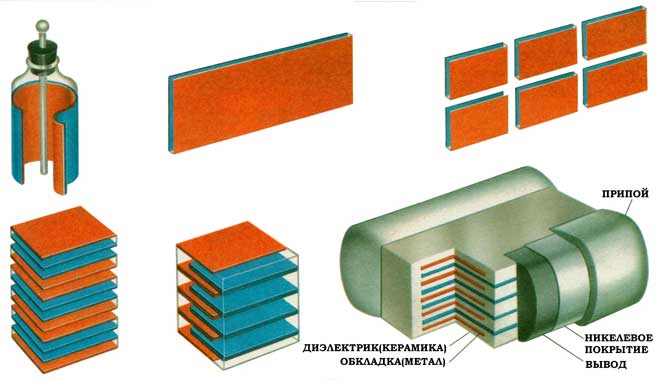
Film dielectrics come in different types. The most common is lavsan, which is highly durable. Less common is polypropylene dielectric, which has lower losses and is used in high-voltage circuits such as audio amplification and midrange circuits.
A separate type of film capacitors are starting capacitors, which are used when starting motors and, due to their high capacitance and special dielectric material, reduce the load on the electric motor. They are characterized by high operating voltages and electrical reactive power.
Electrolytic capacitors are made in a classic design. The housing is made of aluminum and inside there are coiled metal covers. One of the covers is chemically coated with a metal oxide and the other is coated with a liquid or solid electrolyte to form a dielectric. Due to this construction, electrolytic capacitors have a high capacitance, but the peculiarity of their use over time is its change.
In contrast to ceramic and film capacitors, electrolytic capacitors have polarity. They, in turn, are divided into non-polar, devoid of this disadvantage, radial, miniature, axial. Their field of application is traditional computer and modern microcomputer technology.
A special type, which appeared relatively recently, are ionistors. Their structure is similar to electrolytic capacitors, but they have a high capacity (up to several Farads). However, their use is limited by a small maximum voltage of a few volts. Ionistors are used for memory storage: if the battery in a cell phone or a miniature computer runs out, the stored information will not be irretrievably lost.
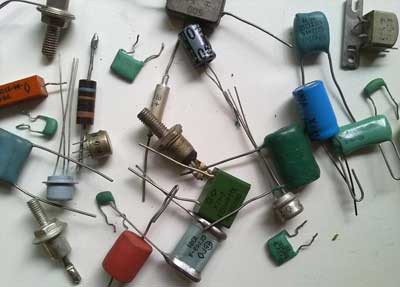
In addition to the pin-type components, which appeared a long time ago and were traditionally used, there are modern components in SMD design or, as it is also called, for surface mounting. For example, ceramic capacitors can be available in a variety of sizes, from the smallest (1 mm by 0.5 mm) to the largest (5.7 mm by 5 mm), and with corresponding voltages from tens of volts to hundreds of volts.
Electrolytic capacitors can also be produced in surface mount packages. These can be standard aluminum electrolytic capacitors, or they can be tantalum capacitors, which look a bit like ceramic capacitors, but differ from them by their higher capacitance and lower losses. They are available in both lead-free and lead-free SMD designs.
Tantalum capacitors are characterized by long life and minimal losses with a slightly lower capacity limit, but they are also very expensive. They are used in high responsibility circuits where high capacitance is required.
Related articles:

